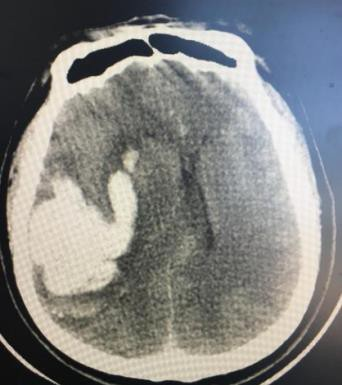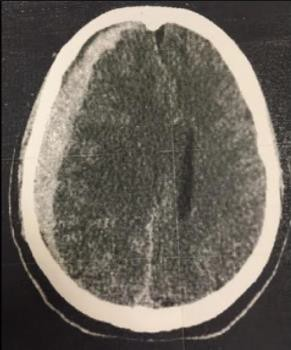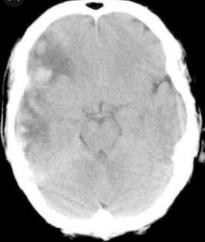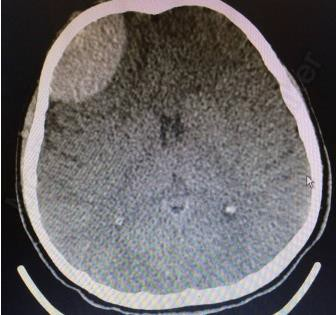2024知到答案 外科总论和各论(吉林大学) 完整智慧树网课章节测试答案
第一章 单元测试
1、单选题:
Hypokalemia generally does not manifest as ( )
选项:
A:alkaline urine
B:feel sick and vomit
C:Decreased tendon reflexes
D:U waves on the ECG
E:alkalosis
答案: 【alkaline urine】
2、单选题:
Patients with metabolic acidosis generally do not present with ( )
选项:
A:Urine is neutral
B:ketone-smelling breath
C:facial flushing
D:increased heart rate
E:take deep and fast breaths
答案: 【Urine is neutral】
3、单选题:
Situations where potassium chloride should not be supplemented in metabolic acidosis is ( )
选项:
A:Urine is acidic
B:Decreased potassium levels in urine
C:Urine output less than 30ml/h
D:Urine output exceeds 60ml/h
E:Urine is alkaline
答案: 【Urine output less than 30ml/h】
4、单选题:
The correct daily amount of water and electrolyte supplementation for fasting and water-free adult patients is ( )
选项:
A:Water 2000~2500ml, sodium 10g, potassium chloride 5g
B:Water 3000~3500ml, sodium 5g, potassium chloride 3g
C:Water 1500~2000ml, sodium 4g, potassium chloride 2g
D:Water 2000~2500ml, sodium 5g, potassium chloride 4g
E:Water 1500~2000ml, sodium 3g, potassium chloride 2g
答案: 【Water 2000~2500ml, sodium 5g, potassium chloride 4g】
5、单选题:
The main organ that maintains fluid balance in the body is ( )
选项:
A:skin
B:buffer system
C:liver
D:lung
E:kidney
答案: 【kidney】
6、单选题:
Electrolyte disturbances associated with metabolic alkalosis are ( )
选项:
A:Hypernatremia
B:Hyperkalemia
C:Magnesium deficiency
D:Hypercalcemia
E:Hypokalemia
答案: 【Hypokalemia】
7、单选题:
Hypokalemic alkalosis often occurs in ( )
选项:
A:Uremia
B:Gastrointestinal decompression
C:crush trauma
D:postoperative oliguria
E:blood transfusion
答案: 【Gastrointestinal decompression】
8、单选题:
In patients with hypokalemia, if the condition does not improve after potassium supplementation, the first consideration should be lack of ( )
选项:
A:calcium
B:sodium
C:Chlorine
D:Phosphorus
E:Magnesium
答案: 【Magnesium】
9、单选题:
The false clinical presentation of hypokalemia is ( )
选项:
A:Polyuria can occur in severe cases
B:Myasthenia is the earliest clinical manifestation
C:Acidic urine in alkalosis
D:typical ECG changes
E:Often coexists with magnesium deficiency
答案: 【typical ECG changes】
10、单选题:
Male, 45 years old. Abdominal distention and vomiting for half a year, more than in the afternoon, spit out overnight food, vomit is large, Comfortable after vomiting, due to prolonged vomiting, in addition to dehydration, it will cause ( )
选项:
A:hypokalemic acidosis
B:hypochloremic hyperkalemic alkalosis
C:hypokalemic alkalosis
D:hypochloremic acidosis
E:Hypochloremic hyperkalemic acidosis
答案: 【hypokalemic alkalosis】
11、单选题:
Female, 45 years old. For pyloric obstruction, continuous gastrointestinal decompression for more than half a month, daily supplement of 10% glucose 2500ml, 5% dextrose saline 1000ml, 10% potassium chloride 30ml. Full abdominal distension, no tenderness and nausea, started 2 days ago Tipping pain, disappearance of bowel sounds, daily urine output of about 1500ml, the most likely cause is ( )
选项:
A:Hypokalemia
B:Hyperkalemia
C:hyponatremia
D:Hypernatremia
E:hypocalcemia
答案: 【Hypokalemia】
12、单选题:
The ideal fluid for hypertonic dehydration is ( )
选项:
A:Balanced Salt Solution
B:10% glucose solution
C:0.45% sodium chloride solution
D:5% sodium bicarbonate solution
E:0.9% sodium chloride solution
答案: 【0.45% sodium chloride solution】
13、单选题:
( ) of extracellular fluid in adult body weight
选项:
A:35%
B:40%
C:25%
D:30%
E:20%
答案: 【20%】
14、单选题:
Male, 35 years old, miner. Weight 60kg. Trapped underground for 8 days, he was thirsty and manic after being rescued, his weight dropped to 55kg, and his serum sodium was 155mmol/L. He should be initially diagnosed as ( )
选项:
A:moderate dehydration
B:severe dehydration
C:hypotonic water deficit
D:mild dehydration
E:isotonic water deficit
答案: 【severe dehydration】
15、单选题:
The common feature of all types of shock is that ( )
选项:
A:Decreased central venous pressure
B:Insufficient microcirculation perfusion
C:blood pressure drop
D:Decreased urine output
E:Decreased pulse pressure
答案: 【Insufficient microcirculation perfusion】
16、单选题:
The performance of shock compensation period is ( )
选项:
A:Slightly higher blood pressure, faster pulse, no change in pulse pressure
B:Blood pressure rises slightly, pulse and pulse pressure are normal.
C:slightly lower blood pressure, faster pulse, smaller pulse pressure
D:slightly higher blood pressure, faster pulse, smaller pulse compression
E:blood pressure decreases slightly, pulse and pulse pressure are normal
答案: 【slightly higher blood pressure, faster pulse, smaller pulse compression】
17、单选题:
The most simple and effective index to reflect the tissue perfusion volume of shock patients is ( )
选项:
A:consciousness
B:pulse
C:limb temperature
D:urine volume
E:Blood pressure
答案: 【urine volume】
18、单选题:
Shock patients with low blood pressure and normal central venous pressure should be given a ( )
选项:
A:vasoconstrictors
B:diuretics
C:a lot of corticosteroids
D:Cardiotonics
E:vasodilators
答案: 【Cardiotonics】
19、单选题:
It should be the first choice to supplement blood volume for shock patients ( )
选项:
A:plasma
B:Whole blood
C:5% glucose solution
D:low molecular dextran
E:balanced salt solution
答案: 【balanced salt solution】
20、单选题:
The key to treating shock is ( )
选项:
A:apply adrenocortical hormone
B:maintain important organ functions
C:apply vasoactive drugs
D:Correct acid-base imbalance
E:supplement blood volume
答案: 【supplement blood volume】
21、单选题:
Vasodilator a must be used in the process of anti shock ( )
选项:
A:large dose
B:continuous intravenous drip
C:as soon as possible
D:After supplementing the blood volume,
E:use in combination with vasoconstrictor
答案: 【After supplementing the blood volume,】
22、单选题:
The blood pressure and central venous pressure of shock patients are low, indicating ( )
选项:
A:cardiac insufficiency
B:excessive vasoconstriction
C:Serious insufficient blood volume
D:relatively insufficient blood volume
E:relatively excessive blood volume
答案: 【Serious insufficient blood volume】
23、单选题:
What are the indicators reflecting the critical condition of shock patients ( )
选项:
A:high fever
B:Systolic blood pressure is lower than 10.7kpa (80mmHg)
C:multiple petechiae and ecchymosis spots appear on the skin
D:fine pulse speed 120 times / min
E:Apathy
答案: 【multiple petechiae and ecchymosis spots appear on the skin】
24、单选题:
Female, nervous, irritable, pale, reduced urine output and low pulse pressure. Should be given first ( )
选项:
A:cardiotonic
B:diuretic
C:Vasoconstrictor
D:vasodilator
E:intravenous rehydration
答案: 【intravenous rehydration】
25、单选题:
Male, after severe trauma, low blood pressure, rapid pulse, pale complexion, diagnosed as shock. What should be paid attention to when treating ( )
选项:
A:toxicity of drugs to various organs
B:Occurrence of acute renal failure
C:rapid expansion of blood volume
D:avoidance of vasoconstrictors
E:timely use of mannitol
答案: 【Occurrence of acute renal failure】
26、单选题:
Male, post-traumatic hemorrhage, irritability, clammy extremities, pulse 105 beats/min, low pulse pressure. should be considered as ( )
选项:
A:Intermediate shock
B:no shock
C:Late shock
D:DIC formation
E:Early stage of shock
答案: 【Early stage of shock】
27、单选题:
female. For volume expansion therapy due to shock, during rapid infusion, the central venous pressure is 1.47kPa (15cmH2O) BP 10.7/8kPa (80/60 mmHg). The measure to be taken is ( )
选项:
A:Suspend the infusion
B:Control the speed and slow down the infusion
C:Slow the infusion and add inotropes
D:with vasopressors
E:Mass infusion to speed up the speed
答案: 【Slow the infusion and add inotropes】
28、单选题:
Male, central venous pressure 0.98kPa (10cmH2O), BP 10.7/8kPa (80/60 mmHg), after rapid instillation of 250ml normal saline, central venous pressure was 1.47kPa (15cmH2O), BP was still 10.7/8kPa (80 /60mmHg). prompt the patient ( )
选项:
A:hypervolemia
B:cardiac insufficiency
C:mild hypovolemia
D:severe hypovolemia
E:volume vasoconstriction
答案: 【cardiac insufficiency】
29、单选题:
The stage of clinical shock is equivalent to the stage of pathophysiology of shock ( )
选项:
A:Normal microcirculation
B:Microcirculatory spasm
C:Microcirculation expansion period
D:Microcirculation failure stage
E:Microcirculation compensation period
答案: 【Microcirculation expansion period】
30、单选题:
Observe the urine volume of shock patients, indicating that the minimum suitable for tissue perfusion is ( )
选项:
A:30ml/h
B:20ml/h
C:0ml/h
D:40ml/h
E:50 ml/h
答案: 【30ml/h】
31、单选题:
What should be the first choice to supplement blood volume in hemorrhagic shock ( )
选项:
A:10% glucose solution
B:Equilibrium salt solution
C:5% sodium bicarbonate
D:Low molecular dextran
E:Whole blood
答案: 【Equilibrium salt solution】
32、单选题:
What must be done with vasodilators in shock ( )
选项:
A:Normal cardiac function
B:Alternate with vasoconstrictors
C:Diastolic blood pressure not less than 60mmhg
D:Shrinkage pressure 90mmHg
E:Blood volume supplement
答案: 【Blood volume supplement】
33、单选题:
With regard to the care of shock patients, the following is incorrect ( )
选项:
A:Vasoconstrictors were given routinely
B:Observe vital signs
C:Establish unobstructed venous channels
D:Record incoming and outgoing volume
E:Routine oxygen supply
答案: 【Vasoconstrictors were given routinely】
34、单选题:
In order to increase plasma osmotic pressure and circulating blood volume, the solution to be selected is ( )
选项:
A:5% glucose
B:0.9% normal saline
C:10% glucose solution
D:Low molecular dextran
E:5% sodium bicarbonate
答案: 【Low molecular dextran】
35、单选题:
Male patient, 45 years old, duodenal ulcer, sudden massive vomiting, about 700ml of blood, irritability, pale complexion, wet and cold skin, BP104 / 90mmHg, P102 times / minute, which belongs to ( )
选项:
A:Late shock
B:Collapse
C:Shock stage
D:Early shock
E:No shock occurred
答案: 【Early shock】
36、单选题:
A shock patient has dyspnea and cyanosis, no change in oxygen supply, and PaO2 continues to decrease to 51mmhg. It is necessary to take the correct measures ( )
选项:
A:Application of pressor
B:Oxygen supply without positive expiratory pressure
C:Sufficient volume expansion to speed up infusion
D:Continuous inhalation of pure oxygen
E:The infusion is mainly colloidal solution
答案: 【Oxygen supply without positive expiratory pressure】
37、单选题:
The patient, male, 40 years old, is in septic shock and is undergoing rapid infusion. CVP (central venous pressure) 18cmh2o, BP 80 / 60mmhg and urine volume 20ml / h are monitored. What should be done ( )
选项:
A:Slow infusion
B:Slow down the infusion and give cardiotonic
C:Infusion at the original speed plus diuretics
D:Accelerated infusion
E:Maintain the status quo
答案: 【Slow down the infusion and give cardiotonic】
38、单选题:
in the early stage of hypovolemic shock, the most vulnerable organ is ( )
选项:
A:Liver
B:Kidney
C:Spleen
D:Lungs
E:Heart
答案: 【Kidney】
39、单选题:
Oliguria in the early stage of shock is due to ( )
选项:
A:Postrenal renal failure
B:Organic renal failure
C:Renal failure
D:Acute renal failure with dysfunction and tubular necrosis
E:Prerenal renal failure
答案: 【Prerenal renal failure】
40、单选题:
Ischemia and hypoxia of tissue cells during shock will inevitably lead to ( )
选项:
A:Lactic acid accumulation
B:Ketone body accumulation
C:Metabolic alkalosis
D:Hypercapnia
E:Respiratory alkalosis
答案: 【Lactic acid accumulation】
41、单选题:
the most common cause of septic shock is ( )
选项:
A:Virus
B:Gram negative bacteria
C:Fungi
D:Spirochete
E:Gram positive bacteria
答案: 【Gram negative bacteria】
42、单选题:
The characteristics of arterial blood pressure changes in the early stage of shock are ( )
选项:
A:First up and then down
B:First down and then up
C:Reduce
D:The change is not obvious
E:Rise
答案: 【The change is not obvious】
43、单选题:
The occurrence of heart failure during shock is not related to which of the following mechanisms ( )
选项:
A:Decreased coronary blood flow
B:Multiple toxic factors inhibit myocardium
C:Front load increase
D:Increased myocardial oxygen consumption
E:Acidosis and hyperkalemia inhibit myocardium
答案: 【Front load increase】
44、单选题:
Female, 50 years old. He was admitted to hospital for 5 days of repeated vomiting. Serum sodium 118mmol/L, pulse 120 beats/min, blood Pressure 70/50mmHg. should be diagnosed as ( )
选项:
A:severe sodium deficiency
B:moderate dehydration
C:severe dehydration
D:mild sodium deficiency
E:moderate sodium deficiency
答案: 【severe sodium deficiency】
45、单选题:
The rate of potassium supplementation should generally not exceed ( ) per hour
选项:
A:50 mmol
B:20 mmol
C:10mmol
D:30 mmol
E:40 mmol
答案: 【20 mmol】
46、单选题:
Hypotonic dehydration mainly refers to ( )
选项:
A:low blood potassium
B:low blood calcium
C:low blood phosphorus
D:low blood sodium
E:low blood magnesium
答案: 【low blood sodium】
47、单选题:
The detection value of serum potassium in patients with intestinal obstruction is 2.9mmol/L, which is generally not clinically manifested as ( )
选项:
A:Weakness of limbs
B:pale skin
C:bitter
D:Paradoxical aciduria
E:ST segment decline
答案: 【pale skin】
48、单选题:
Which of the following is not surgical infection ( )
选项:
A:SSI
B:Urinary tract infection
C:TB
D:CLABSIs
答案: 【TB】
49、单选题:
Which of the following is a common host factor for surgical infection ( )
选项:
A:Gender
B:Physical exercise habit
C:Mental status
D:DM
答案: 【DM】
50、单选题:
Which of the following is not a common etiology for postoperative fever ( )
选项:
A:SSI
B:Hypoglycemia
C:UTI
D:Atelectasis
答案: 【Hypoglycemia】
第二章 单元测试
1、单选题:
The GSC score for patients with concussion usually is? ( )
选项:
A:8-10
B:13-15
C:5-8
D:3-8
答案: 【13-15】
2、单选题:
Which of the following is incorrect about concussion? ( )
选项:
A:The loss of consciousness is usually shorter than 60 min
B:The neurological function impairment is usually reversible
C:The conventional head CT scan is usually normal
D:Occurs instantly following the injury
答案: 【The loss of consciousness is usually shorter than 60 min】
3、单选题:
Which of the following is incorrect about concussion? ( )
选项:
A:Amnesia could be longer than 24 h
B:The amnesia experienced by patients are all retrograde
C:Concussion patients could have anterograde amnesia
D:Amnesia is usually shorter than 24 h
答案: 【The amnesia experienced by patients are all retrograde】
4、单选题:
Which of the following is not related to concussion? ( )
选项:
A:Insomnia
B:Blurry vision
C:Limb paralysis
D:Headache
答案: 【Limb paralysis】
5、单选题:
Which of the following is incorrect about post-concussion syndrome? ( )
选项:
A:Takes place 3 days after the injury
B:Medication could alleviate certain symptoms
C:Patients could have symptoms of irritability, dizziness and fatigue
D:Occurs in about 10-15% of patients.
答案: 【Takes place 3 days after the injury】
6、单选题:
The definition of prolonged post-concussion syndrome is when the symptoms last longer than? ( )
选项:
A:1 Month
B:12 months
C:3 months
D:6 Months
答案: 【12 months】
7、单选题:
Which of the following is not a common etiology of concussion ( )
选项:
A:Crush injury
B:Car accident
C:Fall
D:Sport
答案: 【Crush injury】
8、单选题:
Which of the following imaging study is most commonly used when a patient is suspected with concussion? ( )
选项:
A:X-ray
B:CT
C:MRI
D:PET
答案: 【CT】
9、单选题:
What is the most commonly used method for the definitive diagnosis of diffuse axonal injury?( )
选项:
A:β -Amyloid Precursor Protein immunostaining
B:CT
C:electroencephalogram
D:MRI
答案: 【β -Amyloid Precursor Protein immunostaining】
10、单选题:
Diffuse axonal injury is commonly encountered in? ( )
选项:
A:Crush injury
B:Deceleration injury
C:Whiplash injury
D:Acceleration injury
答案: 【Whiplash injury】
11、单选题:
The pathology of diffuse axonal injury is?( )
选项:
A:B and C
B:Primary axotomy
C:Secondary axotomy
D:demyelination
答案: 【B and C】
12、单选题:
Which of the following is not the susceptible location for diffuse axonal injury?( )
选项:
A:Corpus callosum
B:Brain stem
C:Precentral gyrus
D:Corona radiate
答案: 【Precentral gyrus】
13、单选题:
Which of the following is not a common feature of diffuse axonal injury( )
选项:
A:Usually concurrent with cerebral contusion
B:Vegetative stage
C:Persistent coma
D:Seizure
答案: 【Seizure】
14、单选题:
What is severe diffuse axonal injury based on clinical severity( )
选项:
A:coma of 24 to 48 hours’ duration
B:coma of more than 48 hours without decerebrate posturing
C:coma of more than 24 hours with decerebrate posturing or flaccidity
D:coma of more than 48 hours with decerebrate posturing or flaccidity
答案: 【coma of more than 24 hours with decerebrate posturing or flaccidity】
15、单选题:
Which of the following is not the common clinical manifestation of cerebral contusion and laceration? ( )
选项:
A:Normal CSF routine
B:focal neural deficit
C:Post-operative coma usually last longer than 30 min
D:Vital sign changes
答案: 【Normal CSF routine】
16、单选题:
Which following portion of the brain is most likely to be injured during contra-coup contusion? ( )
选项:
A:Brain stem
B:Occipital lobe
C:Frontal lobe
D:Cerebellum
答案: 【Frontal lobe】
17、单选题:
What is the most appropriate management for a contusion patient with pupil size L =4 mm: R=2 mm, negative light reflex on the left and stable vital signs? ( )
选项:
A:Bed rest
B:Medication
C:decompression with lumbar puncture
D:Emergency surgery
答案: 【Emergency surgery】
18、单选题:
Which of the following is used to detect early or small cortical contusion ( )
选项:
A:MRI
B:PET-CT
C:CT
D:X-ray
答案: 【MRI】
19、单选题:
Which of the following contusions have similar biomechanical mechanism with diffuse axonal injury and concussion? ( )
选项:
A:Fracture contusion
B:contra-coup contusion
C:Gliding Contusion
D:Coup contusion
答案: 【Gliding Contusion】
20、单选题:
Which of the following is not the common secondary events following cerebral contusion? ( )
选项:
A:Cell cycle changes
B:Ischemic necrosis
C:Vasogenic edema
D:Inflammatory response
答案: 【Cell cycle changes】
21、单选题:
Which of the following is more likely to recover spontaneously? ( )
选项:
A:Contusion of brain stem
B:Contusion of the precentral gyrus
C:Contusion of cerebellum
D:Contusion of hypothalamus
答案: 【Contusion of cerebellum】
22、单选题:
What is the most important management when a conscious contusion patient fall into progressive decline in consciousness level? ( )
选项:
A:CT scan
B:Lumbar puncture
C:Emergent surgery
D:Intravenous mannitol
答案: 【CT scan】
23、单选题:
Which of the following is not a common surgical intervention for the treatment of contusion? ( )
选项:
A:Decompressive craniectomy
B:Third ventriculostomy
C:EVD
D:Evacuation of hematomas
答案: 【Third ventriculostomy】
24、单选题:
In which of the following, surgery is not considered? ( )
选项:
A:Midline shift
B:Development of supratentorial hematoma with volume larger than 40 ml
C:Early stage of cerebral hernia
D:Vital sign instability
答案: 【Vital sign instability】
25、单选题:
Which of the following image iscerebralcontusion? ()
选项:
A:

B:

C:

D:

答案: 【

】
